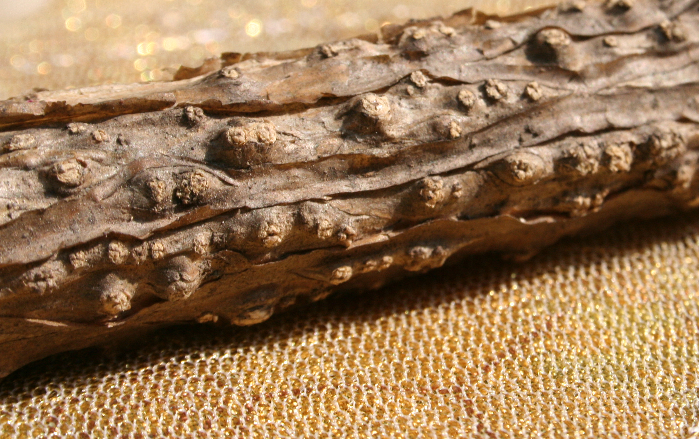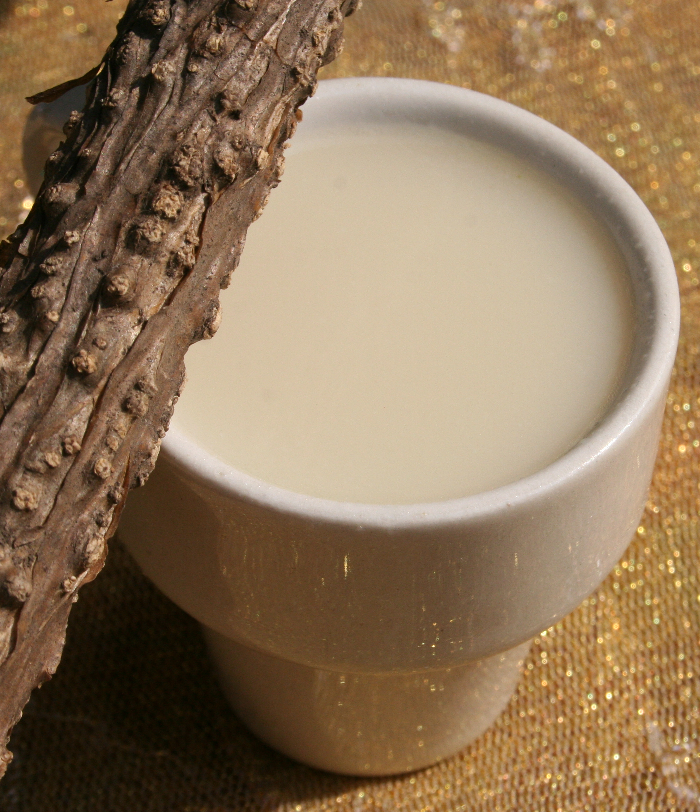Recently my husband brought me a foot-long stick covered in what looked like warts. “It’s from my mom. You put it in tea. It’s called giloy.” I squinted, feeling the rough texture of the stick, still having no clue what the heck giloy was or why I should be spiking my tea with it.

Turns out, giloy is one of the most popular healing herbs in India, and is often used for boosting immunity in winter. Ayurveda even touts giloy as “amrita,” the nectar of immortality.
Giloy (Tinospora Cordifolia) is a climbing plant with heart-shaped leaves. It’s a traditional medication for fevers caused by malaria and dengue. Currently dengue has no cure, so treatments like papaya leaf juice and giloy are widely utilized and recommended by doctors in India.
Other traditional uses for giloy include:
- Respiratory ailments
- Arthritis
- Managing blood sugar
- Anemia
- Indigestion
- Aphrodisiac
- Anti-aging
- Skin disorders
My mother-in-law uses giloy stem for her arthritis, while my husband’s uncle drinks the juice daily as a supportive health tonic. All parts of the plant are used from root to leaf to stem, but the stem is the most widely utilized. Giloy is available in juice, capsules, powder, and dried parts.
Due to its widespread renown as a healing herb, giloy is even being touted as a “cure” for COVID-19. Obviously, we can’t take hearsay and conjecture as scientific fact. It’s ill-advised to place belief in any medicine (herbal or allopathic) that hasn’t been extensively studied and proven to work. However, giloy does have some proven benefits and contains chemical compounds that may boost immunity. Thus, giloy is potentially helpful in supporting immunity in healthy individuals.
Proven Benefits
While there have been comparatively few studies on giloy despite thousands of years of human consumption, there have been some promising scientific studies on its benefits.
Giloy may help prevent diabetic neuropathy and has the ability to promote insulin production as well as the ability to inhibit gluconeogenesis and glycogenolysis, regulating blood sugar. One study showed that giloy may support insulin production in rats with diabetes.
As an adaptogeic herb, giloy is useful in reducing stress.
Giloy is full of potent antioxidants, which eliminate harmful free-radicals and may help mitigate the symptoms of aging.
The chemical compounds found in giloy are known to have “anti-diabetic, antipyretic, anti-inflammatory, anti-oxidant, hepato-protective, and immuno-modulatory” qualities.
Giloy contains copper, calcium, manganese, phosphorus, iron, and zinc.
Giloy may aid those suffering from allergies. A study on patients with allergic rhinitis concluded that 83% of those treated with giloy extract saw a 100% reduction in their symptoms.
A study on mice concluded giloy has anti-pyretic qualities, is anti-inflammatory, and is an effective analgesic.
Side Effects and Contraindications
Giloy is not advised for breastfeeding or pregnant women and those trying to become pregnant. A study on rats indicated giloy extract decreased male fertility.
Giloy can cause an overstimulated immune system in immunocompromised individuals, and those with auto-immune disorders should not take giloy.
There have been some conflicting reports of liver damage in a small number of patients who reportedly consumed giloy, but it’s unclear whether this was caused by giloy or other factors such as dosage, additional herbal supplements, or mistakenly consuming a similar-looking herb. Still, it’s best to get advice from a medical professional before consuming any herbal medicines, in order to avoid contraindications.

Personal Experience
My son gave me a lovely cold for Christmas, so I decided to see if this wonder plant could work a bit of magic. I grated an inch of giloy stem into a glass of water. Many recipes for giloy tea include milk, so I added some coconut milk in case giloy has compounds that bind to lipids. The grated stem had a sharp, woody scent; not unpleasant but quite pungent all the same.
I boiled the Giloy in the liquid until half of the water had evaporated, producing a concentrated decoction. This took about twenty minutes. At the end I added a bit of tea leaves and sugar, because the taste is supposed to be unpleasant. I strained it into a mug and took a sip.
Unpleasant is an understatement. Choice few colorful words accurately describe the bitter, tannic flavor of giloy, and nectar certainly isn’t one of them. Giloy tea is probably one of the more disgusting things I’ve ever ingested, but I managed to choke down half a cup. Half an hour later, I noticed my cough was less painful, but I’m not sure whether it was a result of drinking hot liquid or the giloy itself.
The second time I made it I omitted the tea leaves, hoping to reduce the bitterness. This time it was slightly more palatable, and I was able to finish the full cup. Again, the severity of my cough was reduced.
Ayurvedic treatments are meant to be taken long-term for results, and in the hopes of staving off yet another respiratory infection (I’m prone to them, thanks to a bout of long-term bronchitis in college), I guess I’ll be drinking more “nectar” this week, with my nose plugged. Bottoms up!
Get more like this—Sign up for our daily inspirational newsletter for exclusive content!
__
Photo: Jessi Ferguson




